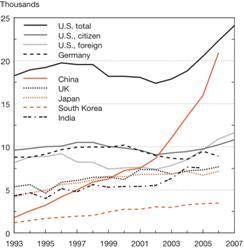The rise of Asia in science
The shifting geography of scientific output
The US has been the world’s largest producer of scientific knowledge for decades, as measured by number of scientific publications in internationally peer reviewed journals[1]. Since 1994, however, EU countries considered as an integrated area, have outperformed the US in terms of number of publications. Now both the US and the EU (as well as Japan) are losing share relative to Asia, and particularly to China (Table 1).
The annual average growth rate for Chinese scientific publications from 1995-2009 is 15 percent. China only represented 2 percent of scientific publishing in 1995, but by 2009 accounted for about 9 percent of world scientific output. Although the most spectacular and consistent over time, China is not the only example of the Asian rise to prominence in science.
South Korea, Taiwan and Singapore have all increased their share of global scientific publishing. South Korea publications growth rate from 1995-2005 was similar to China's, but slowed in the later period 2005-09. India was on par with China in 1995, but its scientific publishing has increased less dynamically, only picking up some speed recently. Japan has remained more or less stagnant, even decreased its share in world publications in the last period, with negative growth rates.
Table 1: The rise of Asia in science
|
All S&E fields |
Share in world total number of publications |
Average Annual Growth Rates of publications |
||||
|
Region/country/economy |
1995 |
2005 |
2009 |
95-09 |
05-09 |
95-05 |
|
United States |
0,34 |
0,29 |
0,26 |
0,01 |
0 |
0,01 |
|
European Union |
0,35 |
0,33 |
0,32 |
0,02 |
0,01 |
0,02 |
|
China |
0,02 |
0,06 |
0,09 |
0,15 |
0,14 |
0,15 |
|
India |
0,02 |
0,02 |
0,03 |
0,05 |
0,08 |
0,04 |
|
Japan |
0,08 |
0,08 |
0,06 |
0 |
-0,03 |
0,02 |
|
Singapore |
0 |
0,01 |
0,01 |
0,09 |
0,04 |
0,12 |
Although Asia’s rise holds for all scientific disciplines, a number of fields stand out. In engineering in particular (but also chemistry, physics, mathematics and computer sciences), Asia and especially China have made the most rapid progress (see also Veugelers, 2010, 2011).
In engineering, China’s share of world publications rose from 3 percent in 1995 to 15 percent in 2009 (Table 2). South Korea has also made substantial progress in engineering, with a share of 6 percent of world publications in this field in 2009. All Asian countries specialise in engineering: their share in this field is greater than their share in all disciplines, as the last column of Table 2 shows. A high degree of specialisation in engineering can be observed in South Korea, Taiwan and China. This specialization pattern reflects these countries’ research priorities, consistent with their emphasis on developing high-technology manufacturing capabilities. Japan has a minor specialisation in engineering, but has also lost relative share in this discipline.
Table 2: Asia’s rise in engineering
|
All S&E fields |
Share in world total engineering articles |
RSA in engineering |
||
|
Region/country/economy |
1995 |
2005 |
2009 |
2009 |
|
United States |
0,3 |
0,207 |
0,183 |
0,7 |
|
European Union |
0,302 |
0,283 |
0,264 |
0,83 |
|
China |
0,03 |
0,109 |
0,153 |
1,7 |
|
India |
0,028 |
0,029 |
0,041 |
1,37 |
|
Japan |
0,118 |
0,102 |
0,069 |
1,15 |
|
Singapore |
0,006 |
0,014 |
0,011 |
1,1 |
|
South Korea |
0,017 |
0,059 |
0,059 |
1,97 |
|
Taiwan |
0,024 |
0,032 |
0,037 |
1,85 |
Source: On the basis of NSF, S&E indicators 2012
Note: RSA (Revealed Scientific Advantage) is the country’s share in engineering articles relative to its share in all S&E articles. A value greater than 1 indicates that the country specialises in engineering.
Researchers: gravitating towards Asia
The building up of Asian scientific capacity is also reflected in rising numbers of bachelor, master and PhD degrees being awarded in Asia. This is evident particularly in the fields of natural sciences and engineering (NS&E), and is happening while government in Western countries are concerned about lagging student interest in NS&E, fields they believe offer the technical skills and knowledge that are essential for knowledge-intensive economies.
Figure 1 shows that the number of NS&E doctorates awarded by Chinese institutes have increased more than tenfold since the mid-1990s, to about 21,000 in 2006, nearing the number of NS&E doctorates awarded in the US. NS&E doctorate awards in South Korea and India have also risen.
Figure 1
Asian rising home production of PhDs
Doctoral degrees in natural sciences and
engineering, selected countries: 1993–2007

Source: NSF, S&E Indicators 2010
Furthermore, most of the post-2002 increase in US NS&E doctorates is accounted for by degrees awarded to foreigners. Foreign nationals have earned more than half of US NS&E doctorates since 2006. Half of these foreign PhD students are from East Asia, mainly from China (31 percent), while for India the figure is 12 percent. South Koreans account for 10 percent of all foreign NS&E PhDs awarded in the US. The rise in Asia's own production of PhDs does not seem to crowd out the flows of doctoral students going from Asia to the US. Similar trends are also observed in the flow of Asian post-doctoral students going to the US (Veugelers 2010, Stephan 2012). The rise in tertiary degrees awarded in Asia seems to have provided an even bigger and better pool of talent for US PhD programmes.
Concluding remarks
This note has demonstrated how new emerging economic powerhouses in Asia are building up their own scientific capabilities. This holds most for China, but is also true for Korea, Taiwan and Singapore. For India, it holds to a lesser extent, while Japan is, like the US and Europe, losing scientific power in relative terms.
This changing geography of the scientific world reflects how selected Asian governments have come to view science and technology as integral to economic growth, and have consequently taken steps to develop their indigenous science and technology infrastructures.
The rise of new emerging science powerhouses in Asia provokes the question of what the impact will be on science, innovation and economic growth. This will be examined in later contributions.
References
Stephan, P., 2012, How economics shapes science, Harvard University Press
Veugelers, R., 2010, Towards a multipolar science world: trends and impact, Scientometrics, 82, 2, 439-456.
Veugelers, R., 2011. A G2 for science? Bruegel Policy Brief, 2011/519, Bruegel Brussels.
[1] Publications and citations as recorded by Thomson’s ISI-Web of science journals, which includes only journals that satisfy a number of quality criteria (internationally peer-reviewed). These journals have some English-language bias, and a disciplinary bias in favour of biomedicine and life sciences.



